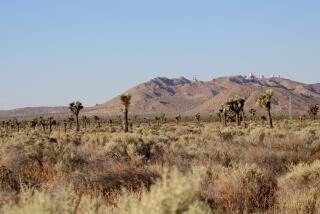Terra-Gen gets OK on wind farm in wake of condor decision
- Share via
MOJAVE, Calif. — Randy Hoyle strode proudly this week along a wind-swept expanse of sand, sage and juniper in the Tehachapi Mountains that will soon bristle with antennas and listening devices designed to protect endangered California condors.
As Hoyle explained, the forbidding terrain is the future home of Terra-Gen Power’s 2,300-acre Alta Windpower Development —and that project will include equipment to detect incoming condors soon enough to switch off the company’s massive wind turbines before they slice into one of the birds.
“When it comes to wind energy production, this project is leading the way in condor avoidance,” said Hoyle, head of wind and solar development for Terra-Gen.
The high-tech equipment and other steps Terra-Gen will take to avoid killing the endangered condors is the chief reason that the U.S. Fish and Wildlife Service has granted the company a unique exception to the Endangered Species Act. For the first time, a company will not be prosecuted if it accidentally kills a condor.
On Friday, the U.S. Bureau of Land Management, with approval from the Fish and Wildlife agency, gave Terra-Gen a right of way to begin construction of the 153-megawatt project, about 100 miles north of Los Angeles.
Fish and Wildlife officials say they believe the likelihood of killing a condor is low at Alta because it is outside the bird’s historic range and it will be situated on the leeward slopes, where thermal updrafts are rare. Condors use updrafts to gain altitude and soar on 10-foot wingspans.
To reduce possible harm to wildlife, including golden eagles, Terra-Gen voluntarily reduced the size of the project from 106 turbines to 51. The 450-foot-tall structures will be spread across four square miles, most of which is publicly owned.
The system will include a telemetry system to track signals from radio transmitters already attached to tagged condors, radar to detect untagged birds and on-site biologists to report condor sightings. If a condor ventures within two miles, the speed of rotating turbine blades will be reduced within 2 minutes to about 3 mph, Terra-Gen said.
The company plans to share its detection data with neighboring wind farms, an alternative energy hot spot in eastern Kern County with thousands of turbines that have been in operation for decades. The company also will provide $100,000 per year to condor recovery activities.
Although other wind farms are using some form of bird detection systems, Steve Henry, Fish and Wildlife deputy field supervisor in Ventura, said Terra-Gen “sets a new standard for wind energy facilities.” The agency is encouraging other wind farm developers to follow suit.
Penalties for killing a condor can be up to $100,000 in fines and one year imprisonment for an individual, and up to $200,000 in fines for an organization. To date, there is no record of a condor fatality linked to a wind energy facility.
The government granted an exception to Terra-Gen: one condor death over the 30-year expected life of the wind farm. No one could say what would happen if Alta exceeds its limit. Critics doubt that the federal government would be willing to shut down the project designed to provide power for more than 45,000 homes and create 15 permanent jobs.
“If this projects takes its first condor within, say, three months, are they really going to tell people they are going to take this energy off line?” asked Eric Glitzenstein, an environmental attorney who represents wildlife organizations.
Environmental groups Friday criticized the agreement with Terra-Gen, saying that more can be done to protect the inquisitive and charismatic species that has long been symbolic of avian conservation.
Garrison Frost, director of marketing and communications for Audubon California, said, “Given the continual technological improvements coming online, the American public has every reason to expect that we can develop renewable energy and ensure that condors will not be killed.”
Today, there are as many condors in the wild as there were in the 1950s, but they cannot survive without constant human assistance. Tens of millions of dollars have been spent over the last three decades on recovery efforts, including captive breeding programs funded by organizations such as the Los Angeles Zoo and the San Diego Zoo Safari Park.
“The California condor is a flagship species of the Endangered Species Act,” said Kelly Fuller, wind campaign coordinator for the American Bird Conservancy. “If taking a condor is allowed, what won’t be allowed?”
Gregory Wetstone, vice president of government affairs for Terra-Gen, said critics miss the point.
“Our project is a pioneering step toward protection of condors,” he said. “We’re bringing in new avoidance technology and condors will be safer because of it.”
More to Read
Sign up for Essential California
The most important California stories and recommendations in your inbox every morning.
You may occasionally receive promotional content from the Los Angeles Times.











